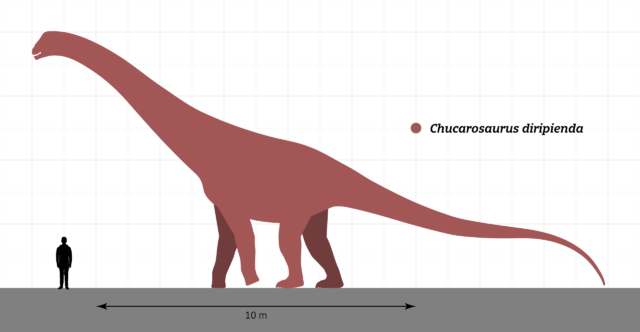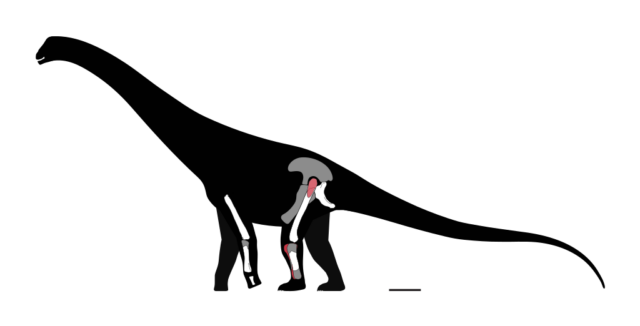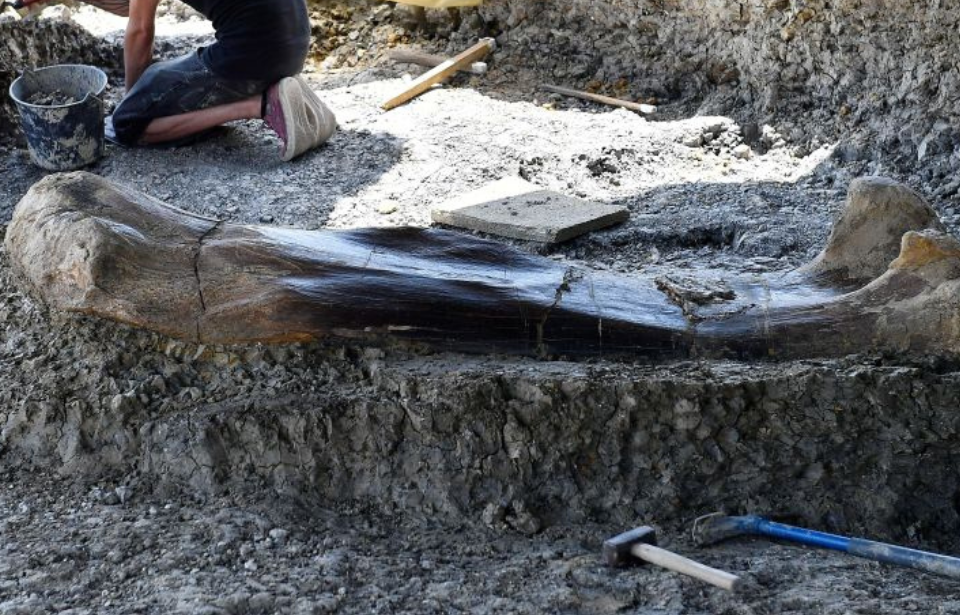When you think of a large, long-necked herbivorous dinosaur, a Brachiosaurus likely comes to mind. Paleontologists conducting a dig in Argentina, however, have unearthed the fossilized remains of one that trumped even the biggest sauropod. It’s so gigantic, in fact, that it’s been described as one of the largest dinosaurs ever discovered.
Paleontologists have discovered a long-necked dinosaur fossil in Argentina that they decided to name as 'Chucarosaurus Diripienda.' The scientists say that the beast ranks as one of the largest ever discovered https://t.co/q1SkMLC2Ny pic.twitter.com/7MVo6tqPm8
— Reuters (@Reuters) May 20, 2023
While the discovery was made in 2018 at the Pueblo Blanco Nature Reserve, it was only recently announced in the journal Cretaceous Research.
Believed to belong to a herbivorous dinosaur that once resided in Argentina‘s Patagonia region – more specifically, what is now the Huincul Formation in the mountainous Rio Negro province – the bones were so large that they caused the van carrying them to a laboratory in Buenos Aires to tip over.
“The weight destabilized the vehicle and caused an accident,” Fernando Novas, a paleontologist at the Bernardino Rivadavia Natural Sciences Museum and the study’s senior author, told Live Science. “Luckily, no one was seriously injured and the bones of this dinosaur, which flew through the air, were so hard that they were not damaged. On the contrary, they broke the asphalt of the road.”
The femur bone, spanning 1.90 meters and half-buried on the hills of the Patagonian steppe, was split into three 100-kilogram pieces and required three people to lift. Additional bone fragments that were unearthed include the humerus, metacarpus, radius, ischium, fibula and tibia.
According to Reuters, the species has been dubbed Chucarosaurus Diripienda by the team as a nod to the van accident. In Latin, the name means “hard-boiled and scrambled.”

Chucarosaurus Diripienda, a member of the Titanosaurian group, is believed to have been 30 feet in length, with an astonishing weight of up to 50 tons. It lived during the Late Cretaceous period, around 100.5 and 66 million years ago. Speaking with Reuters, paleontologist Matias Motta said that, while the sauropod rivaled other large Patagonian dinosaurs in weight and size, its features were much more slender.
Palaeontologist Frederico Agnolin of the Museo Argentino de Ciencias Naturales “Bernardino Rivadavia” explained to SciNews, “Titanosaurs were the most diverse and abundant terrestrial herbivores in the Southern Hemisphere landmasses during the Late Cretaceous. They were globally widespread, and more than 60 valid species are known from South America.
“Titanosaurs are restricted to the Cretaceous and are the most common dinosaurs found in Upper Cretaceous layers of South America, particularly in Patagonia,” he continued.
While described as one of the largest dinosaurs ever unearthed, Chucarosaurus Diripienda isn’t the biggest. That distinction belongs to Argentinosaurus, Patagotitan and Notocolossus, which Novas says weighed around 70 tons.
The paleontologist also explained to Live Science how the sauropod would have used its long appendages. “Its long neck allowed it to feed on the leaves at the top of the trees, and its long tail would have been an effective weapon against attacks by the large carnivorous dinosaurs that lurked in its environment,” he shared.

Argentina ranks in the top three countries worldwide for prehistoric discoveries, alongside the United States and China, with approximately 140 dinosaur species identified.
Patagonia is a region in the southernmost part of South America, spanning Chile and Argentina. Characterized by its rainforests, the Andes, glaciers and deserts, its diverse conditions allowed for a variety of dinosaur species to thrive.
More from us: Archaeologists Discover Rare 7,000-Year-Old Figurine In Italian Cave
The study into the Chucarosaurus Diripienda bones was conducted by researchers from the Azara Foundation, the Museo Argentino de Ciencias Naturales “Bernardino Rivadavia” and CONICET, Argentina’s national research council. Support was provided by the National Geographic Society.
